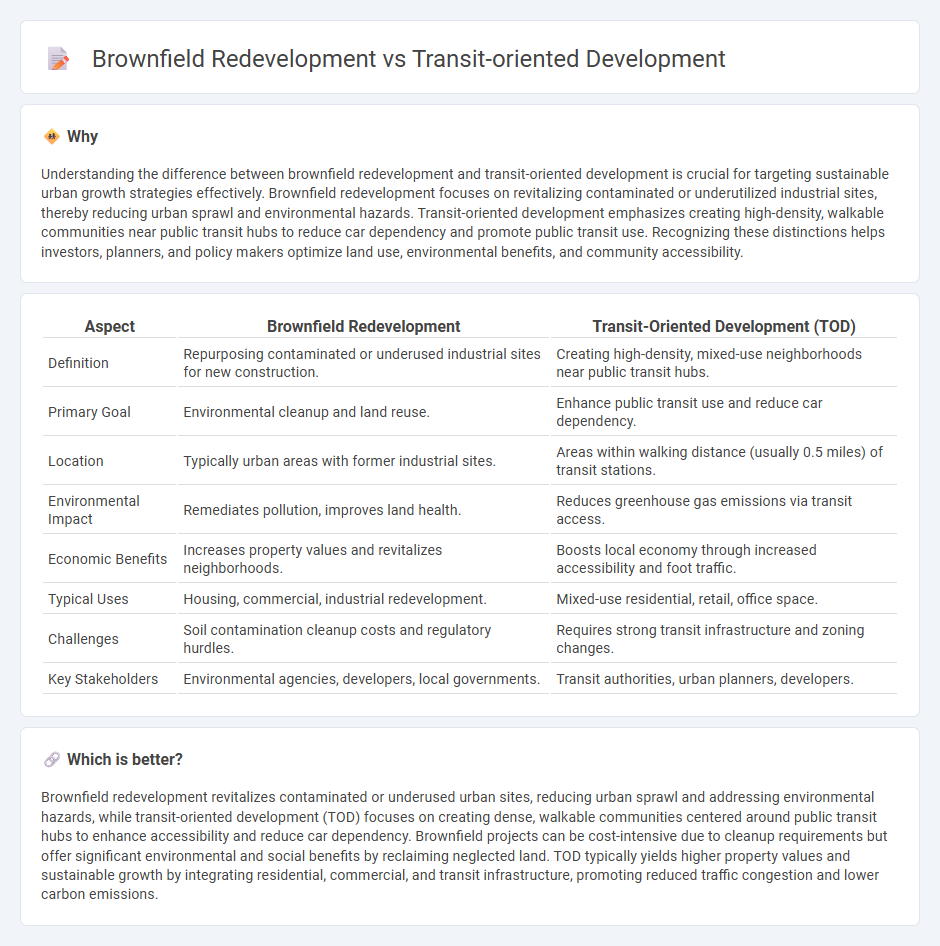
Brownfield redevelopment transforms previously industrial or contaminated sites into valuable real estate, improving urban sustainability and property values. Transit-oriented development (TOD) focuses on creating high-density, walkable neighborhoods near public transit hubs to reduce car dependency and enhance access to amenities. Explore the key differences and benefits of these urban renewal strategies to understand their impact on real estate markets.
Why it is important
Understanding the difference between brownfield redevelopment and transit-oriented development is crucial for targeting sustainable urban growth strategies effectively. Brownfield redevelopment focuses on revitalizing contaminated or underutilized industrial sites, thereby reducing urban sprawl and environmental hazards. Transit-oriented development emphasizes creating high-density, walkable communities near public transit hubs to reduce car dependency and promote public transit use. Recognizing these distinctions helps investors, planners, and policy makers optimize land use, environmental benefits, and community accessibility.
Comparison Table
| Aspect | Brownfield Redevelopment | Transit-Oriented Development (TOD) |
|---|---|---|
| Definition | Repurposing contaminated or underused industrial sites for new construction. | Creating high-density, mixed-use neighborhoods near public transit hubs. |
| Primary Goal | Environmental cleanup and land reuse. | Enhance public transit use and reduce car dependency. |
| Location | Typically urban areas with former industrial sites. | Areas within walking distance (usually 0.5 miles) of transit stations. |
| Environmental Impact | Remediates pollution, improves land health. | Reduces greenhouse gas emissions via transit access. |
| Economic Benefits | Increases property values and revitalizes neighborhoods. | Boosts local economy through increased accessibility and foot traffic. |
| Typical Uses | Housing, commercial, industrial redevelopment. | Mixed-use residential, retail, office space. |
| Challenges | Soil contamination cleanup costs and regulatory hurdles. | Requires strong transit infrastructure and zoning changes. |
| Key Stakeholders | Environmental agencies, developers, local governments. | Transit authorities, urban planners, developers. |
Which is better?
Brownfield redevelopment revitalizes contaminated or underused urban sites, reducing urban sprawl and addressing environmental hazards, while transit-oriented development (TOD) focuses on creating dense, walkable communities centered around public transit hubs to enhance accessibility and reduce car dependency. Brownfield projects can be cost-intensive due to cleanup requirements but offer significant environmental and social benefits by reclaiming neglected land. TOD typically yields higher property values and sustainable growth by integrating residential, commercial, and transit infrastructure, promoting reduced traffic congestion and lower carbon emissions.
Connection
Brownfield redevelopment transforms contaminated or underused industrial sites into valuable real estate, promoting sustainable urban growth. Transit-oriented development (TOD) focuses on creating vibrant, walkable communities near public transit hubs, enhancing accessibility and reducing reliance on cars. Integrating brownfield redevelopment with TOD leverages existing infrastructure, decreases urban sprawl, and boosts property values while supporting environmental remediation and smart growth principles.
Key Terms
**Transit-Oriented Development:**
Transit-Oriented Development (TOD) prioritizes creating walkable, mixed-use communities centered around high-quality public transit systems, enhancing accessibility and reducing reliance on private vehicles. It stimulates sustainable urban growth by integrating residential, commercial, and recreational spaces within close proximity to transit stations, promoting environmental benefits and economic vitality. Discover how TOD reshapes urban landscapes for a greener, more connected future.
Mixed-use zoning
Transit-oriented development (TOD) emphasizes mixed-use zoning by integrating residential, commercial, and public spaces within close proximity to transit hubs, promoting walkability and reducing reliance on cars. Brownfield redevelopment also employs mixed-use zoning to revitalize contaminated or underused industrial sites, transforming them into vibrant urban areas with diverse land uses. Explore how mixed-use zoning drives sustainable urban growth through TOD and brownfield projects.
Public transit access
Transit-oriented development (TOD) maximizes public transit access by concentrating residential, commercial, and recreational spaces within walking distance of transit hubs, enhancing mobility and reducing car dependency. Brownfield redevelopment often involves repurposing contaminated or underutilized urban sites, which may or may not be near public transit facilities, limiting direct transit benefits unless integrated with TOD principles. Explore how strategic planning links TOD and brownfield redevelopment to boost sustainable urban growth and improve transit access.
Source and External Links
Transforming the Urban Space Through Transit-Oriented Development - This webpage discusses the concept of transit-oriented development (TOD) as a planning strategy to concentrate jobs, housing, and services around public transport stations, promoting compact, mixed-use developments.
Transit-Oriented Development | FTA - This page highlights how transit-oriented development supports vibrant communities by integrating dense, walkable, and mixed-use development near transit, enhancing economic health and sustainable growth.
Transit-oriented Development - This Wikipedia entry explains transit-oriented development as an urban planning strategy that maximizes residential, business, and leisure space near public transport, promoting walkability and mixed-use development.
 dowidth.com
dowidth.com